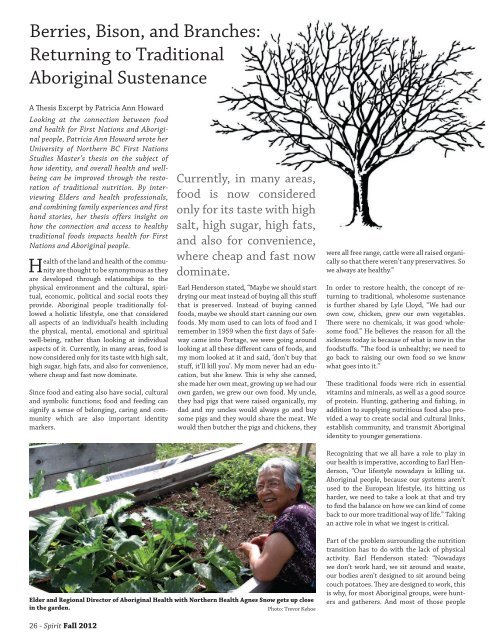1s8Zgsc
1s8Zgsc
1s8Zgsc
You also want an ePaper? Increase the reach of your titles
YUMPU automatically turns print PDFs into web optimized ePapers that Google loves.
Berries, Bison, and Branches:<br />
Returning to Traditional<br />
Aboriginal Sustenance<br />
A Thesis Excerpt by Patricia Ann Howard<br />
Looking at the connection between food<br />
and health for First Nations and Aboriginal<br />
people, Patricia Ann Howard wrote her<br />
University of Northern BC First Nations<br />
Studies Master’s thesis on the subject of<br />
how identity, and overall health and wellbeing<br />
can be improved through the restoration<br />
of traditional nutrition. By interviewing<br />
Elders and health professionals,<br />
and combining family experiences and first<br />
hand stories, her thesis offers insight on<br />
how the connection and access to healthy<br />
traditional foods impacts health for First<br />
Nations and Aboriginal people.<br />
Health of the land and health of the community<br />
are thought to be synonymous as they<br />
are developed through relationships to the<br />
physical environment and the cultural, spiritual,<br />
economic, political and social roots they<br />
provide. Aboriginal people traditionally followed<br />
a holistic lifestyle, one that considered<br />
all aspects of an individual’s health including<br />
the physical, mental, emotional and spiritual<br />
well-being, rather than looking at individual<br />
aspects of it. Currently, in many areas, food is<br />
now considered only for its taste with high salt,<br />
high sugar, high fats, and also for convenience,<br />
where cheap and fast now dominate.<br />
Since food and eating also have social, cultural<br />
and symbolic functions; food and feeding can<br />
signify a sense of belonging, caring and community<br />
which are also important identity<br />
markers.<br />
Currently, in many areas,<br />
food is now considered<br />
only for its taste with high<br />
salt, high sugar, high fats,<br />
and also for convenience,<br />
where cheap and fast now<br />
dominate.<br />
Earl Henderson stated, “Maybe we should start<br />
drying our meat instead of buying all this stuff<br />
that is preserved. Instead of buying canned<br />
foods, maybe we should start canning our own<br />
foods. My mom used to can lots of food and I<br />
remember in 1959 when the first days of Safeway<br />
came into Portage, we were going around<br />
looking at all these different cans of foods, and<br />
my mom looked at it and said, ‘don’t buy that<br />
stuff, it’ll kill you’. My mom never had an education,<br />
but she knew. This is why she canned,<br />
she made her own meat, growing up we had our<br />
own garden, we grew our own food. My uncle,<br />
they had pigs that were raised organically, my<br />
dad and my uncles would always go and buy<br />
some pigs and they would share the meat. We<br />
would then butcher the pigs and chickens, they<br />
were all free range, cattle were all raised organically<br />
so that there weren’t any preservatives. So<br />
we always ate healthy.”<br />
In order to restore health, the concept of returning<br />
to traditional, wholesome sustenance<br />
is further shared by Lyle Lloyd, “We had our<br />
own cow, chicken, grew our own vegetables.<br />
There were no chemicals, it was good wholesome<br />
food.” He believes the reason for all the<br />
sickness today is because of what is now in the<br />
foodstuffs. “The food is unhealthy; we need to<br />
go back to raising our own food so we know<br />
what goes into it.”<br />
These traditional foods were rich in essential<br />
vitamins and minerals, as well as a good source<br />
of protein. Hunting, gathering and fishing, in<br />
addition to supplying nutritious food also provided<br />
a way to create social and cultural links,<br />
establish community, and transmit Aboriginal<br />
identity to younger generations.<br />
Recognizing that we all have a role to play in<br />
our health is imperative, according to Earl Henderson,<br />
“Our lifestyle nowadays is killing us.<br />
Aboriginal people, because our systems aren’t<br />
used to the European lifestyle, its hitting us<br />
harder, we need to take a look at that and try<br />
to find the balance on how we can kind of come<br />
back to our more traditional way of life.” Taking<br />
an active role in what we ingest is critical.<br />
Elder and Regional Director of Aboriginal Health with Northern Health Agnes Snow gets up close<br />
in the garden.<br />
Photo: Trevor Kehoe<br />
Part of the problem surrounding the nutrition<br />
transition has to do with the lack of physical<br />
activity. Earl Henderson stated: “Nowadays<br />
we don’t work hard, we sit around and waste,<br />
our bodies aren’t designed to sit around being<br />
couch potatoes. They are designed to work, this<br />
is why, for most Aboriginal groups, were hunters<br />
and gatherers. And most of those people<br />
26 - Spirit Fall 2012


